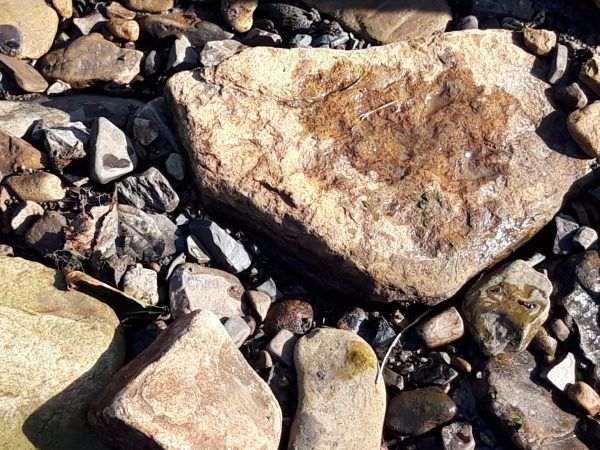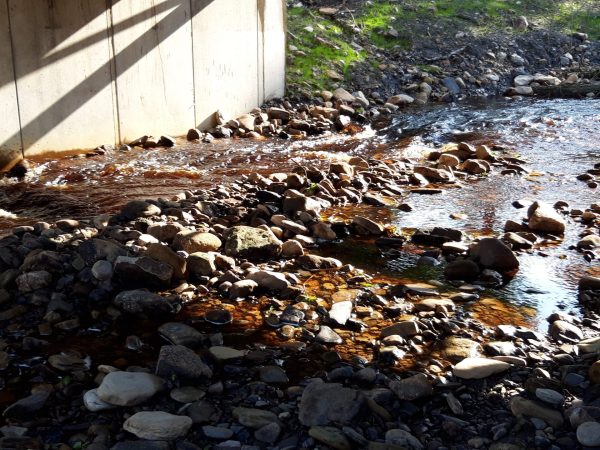News
Eller Beck’s beautiful gravel
Eller Beck blog by Claire Hodgson, Tees-Swale programme manager
 Image credit: Gravel in Eller Beck (c)North Pennines AONB Partnership
Image credit: Gravel in Eller Beck (c)North Pennines AONB Partnership
‘Beautiful gravel’. I’ve never given gravel much thought but this description, from Richard Holmes of the Tees Rivers Trust, made me think again. As did a morning looking at the first Tees-Swale project to be completed – the replacement of a weir with a bridge over Eller Beck, a tributary of the River Greta. ‘Greta’ comes from the Old Norse for ‘stony stream’. It’s also now rare among tributaries of the Tees in that it is not impounded by reservoirs.
This is a project which has been long in the planning and involved many partners. It also hit a bit of a stumbling block when it emerged that what appeared to be a farm track was discovered to be an adopted highway, meaning the specification for the bridge and its construction needed to meet highways standard. The Farming in Protected Landscaped programme came to the rescue with some much-needed additional funding from the North Pennines AONB Partnership’s Farming in Protected Landscapes (FiPL) programme.
Which is how I came to be measuring trout with FiPL colleagues, Cat Kilner and Meg Bamford, after meeting up with a team from Tees Rivers Trust – and pondering on the concept of ‘beautiful gravel’.
It’s easy to see how a weir can impede the progress of fish. This weir was a means of crossing the beck for people and animals. However, it stopped the fish going upstream. What I didn’t understand was the importance of gravel being moved by the beck and therefore providing and improving the spawning habitat for all fish species.
The work will also support the Tees Angling Passport which aims to attract more anglers to the river and bring additional spend to the local economy and rural businesses. Tees Rivers Trust is developing a network of small stream locations, where fishing for small brown trout is a challenge, as part of the passport. Eller Beck is a good offer for this, which in turn could bring additional income to the farm.
The project has contributed to the North Pennines AONB Partnership’s outcome to look after our natural and cultural heritage. The landscape delivers more for nature, farmers and the public, including climate change mitigation and other natural services; the landscape quality and character is protected and enhanced, whilst ensuring essential development takes place; and more and bigger areas of habitat are better connected and managed, and biodiversity loss is reversed.
 Image credit: Eller Beck bridge (c)North Pennines AONB Partnership
Image credit: Eller Beck bridge (c)North Pennines AONB Partnership
The replacement of the weir with a bridge took place in the dry June of 2023. Almost as soon as it was completed, the weather changed and the resulting downpours quickly demonstrated the power of the water to move gravel downstream, no longer impeded by the weir. Suddenly, there was three feet of stone and gravel under the bridge, awaiting the arrival of fish in this autumn’s salmon spawning season.
 Image credit: Stone and gravel under the bridge following heavy rain
Image credit: Stone and gravel under the bridge following heavy rain
(c)North Pennines AONB Partnership
Upstream of the old weir approximately ten kilometres of habitat is now opened up to fish, connecting the upper reaches of this beck to the sea for salmon and other species. Improving nature connectivity through projects such as this lies at the heart of the Tees-Swale: Naturally Connected programme. The programme is funded largely by The National Lottery Heritage Fund and delivered by the North Pennines AONB Partnership in collaboration with the Yorkshire Dales National Park Authority.







